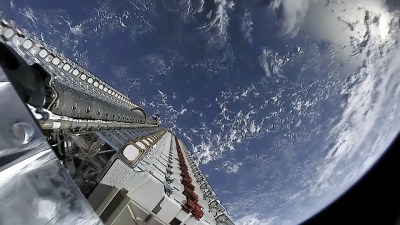Satellite internet used to be a woeful thing. Early networks relied on satellites in geostationary orbits, with high latency and minimal bandwidth keeping user demand low. That was until Starlink came along, and provided high-speed, low-latency internet access using a fleet of thousands of satellites in Low Earth orbit.
Starlink has already ruffled feathers due to concerns around light pollution and space junk in particular. Now, it appears that China may be readying its own competing constellation to avoid being crowded out of low orbits by the increasingly-popular service.
Getting Crowded

Starlink’s plans to launch on the order of 42,000 satellites has Chinese authorities concerned. In response, the country has reportedly developed its own domestic plan to launch 12,992 satellites under a project codenamed “Guowang” or “GW”, according to a professor at the People’s Liberation Army Space Engineering University quoted by the South China Morning Press.
The satellites would form the basis of China’s own national satellite internet network, akin to the efforts by SpaceX and OneWeb. According to Space News, the new network will absorb earlier plans by various Chinese space contractors to create a unified national network. One of the project’s alleged aims is to secure space for Chinese satellites in low orbits before Starlink satellites occupy the area. The news comes from a paper published in a Chinese journal concerning potential anti-Starlink efforts in space. Furthermore, the paper proposes that satellites in the GW constellation could be equipped with “anti-Starlink” payloads, such as to surveil the operation of Starlink satellites at close range.
The paper noted that there were concerns that the high number of satellites planned for the Starlink constellation could overwhelm China’s efforts to monitor and track their activity. Researchers highlighted fears that Starlink satellites could be used as maneuverable weapons to strike targets in orbit, or to surveil the space environment. It bears noting that Starlink was primarily developed as a civilian communications system, though it does have significant military applications like most communications systems do. By sheer virtue of their extreme number and their manuverability, Starlink satellites pose a risk that others simply don’t. SpaceX has also been contracted by the US to develop military satellites, further raising the hackles of foreign countries.
It’s this reasoning that prompted researchers to explore potential countermeasures to disrupt or suppress Starlink satellites in orbit. In a military sense, current anti-satellite countermeasures simply wouldn’t be practical to destroy a megaconstellation of over 40,000 satellites. Using current missiles for the job would create enough space junk to seriously frustrate a wide range of space operations, recalling the dreaded Kessler syndrome. Instead, however, if another country had its own fleet of thousands of satellites in similar orbits with appropriate countermeasures, it may be better placed to disrupt their operation in other ways. Research efforts into anti-Starlink countermeasures are in their early stages, and anything truly valuable is likely classified. However, it’s nonetheless worth noting that Chinese scientists are exploring how best the GW constellation could counter the perceived military threat of Starlink.
Civilian Concerns

The GW satellites would consist of a variety of sub constellations operating from 500 to 1,145 kilometers in altitude, in inclinations from 30 to 85 degrees. That’s right in the realm of Starlink’s operational region, which operates three shells of satellites in orbits around 340, 550, and 1,110 kilometers. Starlink currently operates in the Ku, Ka, and E bands, while China’s satellites could yet use a range of different frequencies for communication. Private Chinese space firms have been testing satellites operating in Q, V, and Ka bands, but it is unclear if this work plays a role in the GW project.
The prospect of yet another megaconstellation of satellites also raises new risks for space safety. Recent years have already seen Starlink satellites narrowly pass a Chinese space station, and further incidents would be expected as satellite numbers increase. Presently, efforts to limit space junk and orbital debris haven’t come to much, and multiple countries and companies throwing tens thousands of satellites into orbit will only make things worse. Traffic management will also be key to deconflicting potential collisions before they occur. New strategies and technologies may be key in this regard. As it stands, keeping tens of thousands of satellites from hitting each other could overwhelm ground controllers tasked with the job.
Fundamentally, the world is entering a new kind of space race. There’s plenty of orbital real estate up for grabs right now. There is also money to be made by those who can supply high-speed bandwith to civilian and military users around the globe. Chinese interests naturally want a piece of the action, and the military research apparatus is also cognisant of the threat these new systems pose. In much the same way that multiple countries proliferated a range of satellite positioning systems, we’re now seeing the same happen with low-earth orbit internet.
















Lessens less chances of them tampering with Starlink. Although the “great firewall from space” might be a problem.
They would simply ban receivers in China, like they already ban VPNs.
The bigger issue is the race to weaponize space that SpaceX has started with Starlink. It was obvious this was going to happen. China, and the EU, and probably India at some stage, will all want their own satellite interest constellations at a minimum. We have already seen how important they are in Ukraine.
From there thoughts naturally turn to how to protect those constellations, and how to deny the enemy access to their ones. When it’s a couple of dozen satellites, missiles will do. When it’s 10s of thousands, countries have to consider deliberately creating Kessler Syndrome as a last resort measure.
I’m actually glad China is considering other options, because that makes simply denying everyone access to those orbits one of the less attractive choices.
there’s a lot of them, but they’re on unstable orbits, the resulting kessler syndrome would fix itself in less then 20 years. Also, low orbits mean it’s easier to zap them with directed energy…
So much easier to read everyone’s comms if you control the back-haul.
Many countries have banned chinese companies from their 5G networks to prevent spying.
I’m kind of worried about what happens to the Chinese citizenry who use workarounds when they realize their VPN’s not so private anymore. Highly doubt a LAN is even an option.
Encryption works. They need to control the software stack too
Why pretend both are not completely true?
To be fair here. It doesn’t realy matter if Huawei is spying or not. Or if they would ever intend to do so.
If the chinese government tells them to spy or shut down a telecom network they have to do it.
It is not Huaweis choise. If sombody refuses to do so, he gets disapieard, the next guy will do as he was told.
You can’t trust Huawei. Even when everybody at the company is trustworthy. It is not even their fault.
Wait… what?
China are going to launch a “Space Junk”?
B^)
As long as they don’t collide with the Starlink satellites, it’s all good.
But they will collide.
I believe that may be the real goal here.
The chance of hitting another satellite depends on the speed and thus height of the two systems. It’s not likely they will use the same height so hitting each other is near impossible.
Clearly looks like a “look ma, that white magician glove”. I’m pretty sure these sat will contain a telescope and a network of 12k satellites means instant observation of any place on earth (in addition to the network stuff to send the data down to Earth, and auxiliary, internet service).
While the excuse of fighting against Starlink is claimed, there’s always a hidden reason in Chinese move.
Fighting starlink is just mathematically weak. The area of a the 500km sphere is 594×10⁶ km². Even if a starlink sattelite is using 30m² of this area, 42 000 of those would only use 1.26km² or 2.10^-9 of the available area. The probability of a collision between two of them is so low, you’d better play lottery.
And you can multiply this probability by each 10m layer (at 500.010 km, 500.020 km) and so on, since each layer have a free area of the same surface.
Said differently, the chance of collision are probably below the epsilon of a float. China wants to spy on the communication and/or blocks them (but again, if starlink starts to use focused optical/laser communication as planned, good luck disturbing it). Their real intend is clearly not what they claim.
Unless that telescope is of a decent size, it will be of limited use. Even if there are 12000 of them. So that idea is a pile of bovine manure.
Also a low-tech satellite war is rather quite simple. It requires a steel ball and a way to add delta-V to it. Like a bit of explosives. Just point the ball on correct trajectory, computed just right and add delta-V. It will hit the target, damage it and change its orbit. You could possibly create an entire cloud of steel balls to sweep across the orbits of all those Musk’s toys.
Another option is to just interfere with communications between satellites. Either by performing an Satellite in the Middle attack on communications, or by just jamming them…
Yet another option: just make a giant cloud of millions of mylar strips coated with aluminum under or among target satellite cloud. A long-term and cheap jamming option. And if the satellites get entangled in the strips, it will change their orbital speed, maybe enough to deorbit them.
These concepts of orbital war were discussed since before first satellites started to orbit Earth.
One problem with using ‘window’ in space. It gets swept out of orbit very quickly simply because it acts as an effective light sail. When the weight is that low, sunlight exerts a nontrival (and continuous, except during the shadow part of the orbit) thrust. It doesn’t really matter which vector the solar thrust is adding, the result will be significant change in orbit.
You can do the math on a napkin or use KSP to sim it, or even one of the more professional orbital simulation packages. The result isn’t promising.
Or, if you prefer experiment rather than simulation, you might find Project Needles/Project West Ford interesting. (It’s sometimes spelled Westford…)
This was using fine copper wire dipoles, which have much more mass than mylar strands, so the mylar would be affected much worse (and dissipate much faster).
I think that they were discussing jamming in the paper.
Satellite orbits aren’t nearly so well behaved as your math presumes. Orbits vary continuously due to various sources of perturbations. The moon is the biggest, of course, but earth itself doesn’t even cooperate because it’s not a perfect sphere. Gravity is lumpy, with a stronger pull from mountains. Tides slosh around the planet. So the vehicles stray from their paths just enough that the orbits have to be corrected periodically. You can either accept their new orbits, or if you’re concerned about things like potential collisions, you can sometimes afford to burn enough of the limited thruster fuel to nudge them out of harm’s way.
Plus, it sounds like China wants to operate in elliptical orbits, crossing a broad range of altitudes, instead of staying in assigned and isolated circular orbits. Elliptical orbits make sense from an efficiency point of view, because the closer they approach earth, the less transmitter power is required to use them. But the lower they get, the more atmospheric drag affects their orbits. And the more orbits they share, the more likely the collisions become.
And collisions are a lot more probable than you calculated. You have to account for the Birthday Paradox. Any two given satellites may have an infinitesimal chance of colliding, but when you have a constellation of 40,000 crossing each others’ paths, the exponential number of combinations converges towards non-negligible odds of a collision. And as someone has already mentioned the Kessler Syndrome, one cloud of debris suddenly becomes a shotgun blast of thousands of untracked micrometeorites that will threaten more spacecraft in similar orbits.
It’s a very real problem.
You mean like all the existing commercial observation constellations from vendors such as Planet Labs?
Yet another junk link to frustrate astronomers with space trash…
If by ‘Yet another’ you pointed Starlink then go to hell for calling working satelites space trash. Just because you live somewhere with usable wired internet connection (or better… can afford to buy a home at such place!!!) doesn’t mean other people do.
Calling them space yeah she’s not negate their value, these are both real problems.
Astronomy from the ground really isn’t that good from a true science perspective anymore – the atmosphere is in the way and while bigger and better optical telescopes can be built you get better results putting them into orbit themselves.
I also personally don’t think they matter to the more to the hobby user – folks get all exicted to catch the ISS, some enjoy the long tail a recent multiple sat launch creates, and for those that don’t their orbits are well enough known and being bright and fast moving relatively easy to remove. Not saying it isn’t going to be annoying, extra effort or cause some detail loss, but I’d suggest it is actually a far smaller problem than the move to very ‘white’ and bright street and car headlights…
Starlink is not primarily civilian if you go by total revenue. Ultimately this was a defense program from the very beginning. See Michael D. Griffin and his early work with Elon and the Space Development Agency.
Interesting point. Worth looking into.
You need to recognize a fleet of hunter-killer sats when you see one.
I’m torn whether it’s the informational advantage that the PLA is worried about, or the sheer mass of maneuverable, disposable satellites, the newer generation of which are going to be equipped with powerful lasers…
At least in the US Free Market, a company like Space-X / Starlink wouldn’t have any reason to be beholden to the US Gov’t, right? I mean, ignoring that gov’t contracts and investment make up the bulk of their funding.
Makes Huawei look clean. At least they sell mobile phones at a profit.
Hey if I wanted China to read my email and steal my credit cards I’d use Hauwei like everyone else!
Fun fact: they did a security review of smartphones once and the Huawei model’s worst spying was done by the Microsoft keyboard they used, which was sending a shitload of info to Microsoft servers…
But yeah.. worry about the Chinese, who won’t use info against western people, but do not worry about the US who get all countries to arrest people under insane laws and secret court orders to give them 400 years prison for non-crimes.Yay for our freedom.
Anyway, sorry to interupt your propaganda, please continue.
I expected a bunch of vile responses in comments about this, so thank you for being out here saying what needs to be said: China isn’t the problem, the US government is.
If you think that only the US is a problem I can only hope you can’t affect policy.
The Chinese actively used the information they get, what are you talking about? They also arrest people internationally under secret provisions all the time. I’m not going to defend bad practices by the US but at least learn a bit about what you are saying.
Well It looks waaaay cooler than starlink!
https://youtu.be/3G1KBu6H6BM
Yeah, that’s some next level stuff.
The Land of Shortcuts and Surveillance wants to cover the globe in comm sats? Yeah, right.
That greedy madness converges to orbital terrorism.
But (!!!) at least the rest of the solar system will be saved from us when we’re locked in on Earth and then we have no other perspective than to clean up our only home. I like this perspective!
:-Þ
Please go on!
“En-Kessler” us!
Do it!
The sooner, the better!
And with an orbit full of self shreddering debris, war in orbit will not be a topic any more too…
I want it all – I want it NOW!
Kessler Syndrome here we come.
Nothing is ever new under the sun.
Forgot about SDI.
Donald Kessler quote on wikipedia :
“Some of the most environmentally dangerous activities in space include large constellations such as those initially proposed by the Strategic Defense Initiative in the mid-1980s, large structures such as those considered in the late-1970s for building solar power stations in Earth orbit, and anti-satellite warfare using systems tested by the USSR, the US, and China over the past 30 years. ”
Musk has the right to send waste to space.
China does not.